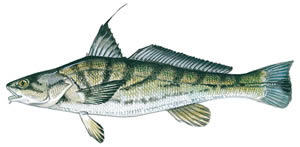Northern Kingfish: A Profile
by Heather Corbett
Assistant Fisheries Biologist
The Northern kingfish, Menticirrhus saxatilis, is popular with many saltwater anglers, and it's no wonder. These fish are known to put up a good fight, and their tasty, white meat is well worth the effort.
 Common Names:
Common Names:
Other names for the Northern kingfish include king whiting, sea mullet, northern whiting, roundhead, sea mink, minkfish, whiting and barb.
Characteristics:
Northern kingfish are part of the drum family, Sciaenidae, which also includes weakfish, spot, Atlantic croaker, red drum and black drum. Since they lack an air bladder, Northern kingfish do notmake typical "drumming" sounds like other members of the drum family, but they can vocalize somewhat by grinding their pharyngeal (throat) teeth.
Notable characteristics are the long spine on the first dorsal fin and a barbel on the chin. Dark, irregular bars are present along the body of the fish. The first two bars form two distinct V-shapes. The bold markings and a dark longitudinal stripe behind the pectoral fins distinguish it from the two other species of kingfish. The markings on Southern kingfish and Gulf kingfish are not nearly as prominent and do not form the V-shaped pattern.
Range:
Northern kingfish are found in the Atlantic Ocean from Maine to Florida and in the Gulf of Mexico from Florida to Yucatan. They are most commonly found from the Chesapeake Bay to New York.
Habitat:
Usually found in schools in shallow coastal waters, Northern kingfish prefer areas with a hard or a sandy bottom. They regularly appear along the Atlantic coast from late April to October. It is unknown where Northern kingfish migrate for the winter, but it is thought to be offshore and in deeper water.
Size:
Northern kingfish can grow 18 inches long and can weigh up to three pounds, but greater lengths and weights have been reported. Commonly, these fish range from 10 to 14 inches long and weigh from one-half to 1.5 pounds. The largest ever recorded anywhere, a three-year-old female caught in a commercial gill net, was more than 21 inches long and weighed 3.3 pounds.
The New Jersey state record was caught in the surf in Margate on Oct. 25, 2003 by Art Higbee, who used bloodworms for bait. The fish was 18¼ inches long and weighed two pounds and six ounces - just three ounces more than the record set 10 years ago.
Spawning and Growth:
Spawning typically occurs at the bottom of bays and sounds, but has been reported to occur outside of estuaries. The spawning period ranges from April until August, depending on the region; older fish tend to spawn first. Males become sexually mature around age two and females around age three. The eggs float, and within 46 to 50 hours, they hatch in waters 68 to 70 degrees Fahrenheit.
Northern kingfish grow quickly during their first year of life. Fish spawned in late May or early June can reach a length of 11.8 inches by October. The major period of growth is from mid-summer to late fall, with little or no growth occurring in the winter.
The average life expectancy of the Northern kingfish is two to three years, although they are known to live as long as four years.
Feeding:
Northern kingfish are bottom feeders that eat shrimp, small mollusks, worms, young fish, crabs and other crustaceans. Compared with other members of the drum family, the smaller eyes, barbel, inferior mouth and body shape indicate that Northern kingfish feed primarily by using their senses of smell and touch.
Commercial Fishing:
Currently, there is no directed commercial fishery for Northern kingfish in New Jersey, so any commercial harvest is landed only as bycatch. In 2002, 1,500 pounds of Northern kingfish were reported harvested commercially in New Jersey. Most were caught by gill nets and otter trawls with only a few caught by fish pots and traps.
Recreational Fishing:
Late summer produces the best results, and fishing can be done in the surf or by boat close to shore. Small hooks and light tackle should be used and clams, bloodworms or squid cut into bite-size pieces are the most effective bait. Fishing in the bay can be done by anchoring in shallow water about eight to 15 feet deep and chumming with clams. Single or double hooks can be used, depending on your preference, with a small weight to assure you are fishing on the bottom. Some anglers like to use bobbers also. The same bait and hooks are used for surf fishing, which is the more popular method. Try retrieving your line slowly to improve your catch.
References:
Bigelow and Schroeder (1953), NMFS (2002), Virginia Tech Web site, http://fwie.fw.vt.edu/www/macsis/fish.htm

 Common Names:
Common Names: